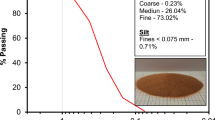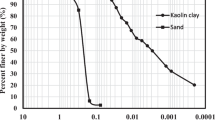Abstract
Hydrophilic polymer grouting with a particular water-to-binder ratio could block soil pores in a short time to prevent the loss of cement slurries in sandy strata in water-rich areas. Meanwhile, when combined with cement, the setting time and permeability of sandy soils could be minimized significantly. In this study, a series of indoor permeability tests, unconfined compression tests, and field grouting tests were conducted to investigate the influence of the ratio of polymer to water, the ratio of water to cement, polymer and cement content on the solidification time, setting time, impermeability effect, and compression resistance of silty sands and summarize the recommended grouting parameters of cement and polymer for the water-rich sandy stratum. The results illustrated that the recommended ratio of the primary and auxiliary agents in the polymer was 2:1. If the solidification time was required to be earlier than the initial hydration time of cement as the standard, the ratio of polymer to water should be higher than 1:3. The setting time of cement- and polymer-stabilized silty sands decreased with curing temperature and polymer content. The permeability coefficient of cement- and polymer-stabilized silty sands decreased nonlinearly with the increase in polymer and cement contents. Their permeability coefficients were basically within the range of 10−6 cm/s. The compressive strength of cement- and polymer-stabilized silty sands decreased with polymer dosage but increased linearly with cement content. The compressive strength and permeability coefficient of the field grouted samples showed that the cement and polymer grouted silty sand had better impermeability than that grouted with the mixture of cement and metakaolin and the mixture of cement, red mud, and phosphogypsum. The permeability coefficient of cement and polymer grouted silty sand after 28 days could reach 0.89 × 10−7 cm/s, while the improvement of their compressive strength was relatively low, with an average value of 2.46 MPa. The failure of cement- and polymer-stabilized silty sands showed typical plastic shear characteristics rather than brittle and splitting characteristics that appeared in the failure of silty sand grouted by cement and metakaolin, or the mixture of cement, red mud, and phosphogypsum. The results of this study can provide a reference for the construction of low-permeability barriers at sandy strata in water-rich areas.

























Similar content being viewed by others
References
Anagnostopoulos CA (2014) Effect of different superplasticisers on the physical and mechanical properties of cement grouts. Constr Build Mater 50:162–168
Anagnostopoulos CA, Sapidis G, Papastergiadis E (2016) Fundamental properties of epoxy resin-modified cement grouts. Constr Build Mater 125:184–195
Burwell EB (1958) Cement and clay grouting of foundations: practice of the corps of engineering. J Soil Mech Found Division 84:1–22
Chen TL, Teng HJ, Zhang DL (2007) Grouting test on water-enriched sand layer of Xiamen Xian’an subsea tunnel. Chin J Rock Mech Eng 26(S2):3711–3717
Consoli NC, Rosa DA, Cruz RC et al (2011) Water content, porosity and cement content as parameters controlling strength of artificially cemented silty soil. Eng Geol 122(3–4):328–333
Construction MO, Supervision GAOQ (2002) Code for investigation of geotechnical engineering
Deng C, Dang F, Chen X et al (2020) Experimental study on grouting effect and mechanical properties of the rockfill materials grouted with SCM. Adv Civil Eng 2020:1–9
Deng YF, Yue XB, Liu SY et al (2015) Hydraulic conductivity of cement-stabilizedmarine clay with metakaolin and its correlation with pore size distribution. Eng Geol 193:146–152
Foliate HC (1951) gravelly alluvium with opened structure (in French). Proceedings of the Fourth Conference on Large Dams, pp 434–520
Hongbo W, Rentai L, Qingsong Z (2019) Development and field test of new environmentally friendly water-rich sand grout material. Adv Mater Sci Eng 2019:1–8
Incecik M, Ceren I (1995) Cement grouting model tests. Bullet Tech Univ Istanbul 48(2):305–317
Ji XM, Tan W (2010) Study of influence of groundwater seepage on reinforcement effect of tunnel surrounding rock in saturated water-bearing sand layer. Chin J Rock Mech Eng 29(S2):3655–3662
Jiang B, Wang Q, Li SC et al (2016) The research of design method for anchor cables applied to cavern roof in water-rich strata based on upper-bound theory. Tunn Undergr Space Technol 53:120–127
Karol RH (1990) Chemical grouting. Marcel Dekker, New York
Kim DJ, Park G, Le HV et al (2016) Fresh and hardened properties of steel fiber-reinforced grouts containing ground granulated blast-furnace slag. Constr Build Mater 122:332–342
Li ZP, Zhang LZ, Chu YT et al (2020) Research on influence of water-cement ratio on reinforcement effect for permeation grouting in sand layer. Adv Mater Sci Eng 2020:1–12
Liao X (2019) Experimental study on plugging characteristics of acrylate grouting materials. Beijing Jiaotong University, Beijing
Liao X (2019) Experimental study on plugging characteristics of acrylate grouting material. BeiJing JiaoTong University, Beijing
Liu W (2020) Study on preparation and properties of magnesium acrylate waterproof material. Shenyang Jianzhu University, Shenyang
Mahmood WI, Mohammed AS (2019) New Vipulanandan p-q model for particle size distribution and groutability limits for sandy soils. J Test Eval 48(5):1–18
Mahmood W, Mohammed AKG (2019) Viscosity, yield stress and compressive strength of cement-based grout modified with polymers. Results Mater 4:100043
Mahmood W, Mohammed A (2020) Hydraulic conductivity, grain size distribution (GSD) and cement injectability limits predicted of sandy soils using vipulanandan models. Geotech Geol Eng 38(2):2139–2158
MHURC of China (2011) Specification for mix proportion design of cement soil
Mohammed A, Mahmood W, Ghafor K (2020) Shear stress limit, rheological properties and compressive strength of cement-based grout modified with polymers. J Build Pathol Rehabil 5(1):3
Mohammed A, Mahmood W, Ghafor K (2022) TGA, rheological properties with maximum shear stress and compressive strength of cement-based grout modified with polycarboxylate polymers. Constr Build Mater 235:117534
Mohammed A, Rafiq S, Mahmood W et al (2020) Microstructure characterizations, thermal properties, yield stress, plastic viscosity and compression strength of cement paste modified with nanosilica. J Market Res 9(5):10941–10956
Ortega JM, Albaladejo A, Pastor JL et al (2013) Influence of using slag cement on the microstructure and durability related properties of cement grouts for micropiles. Constr Build Mater 38:84–93
Pham TA, Koseki J, Dias D (2021) Optimum material ratio for improving the performance of cement-mixed soils. Transp Geotech 28:1–10
Ray S, Daudi L, Yadav H et al (2020) Utilization of Jarosite waste for the development of sustainable concrete by reducing the cement content. J Clean Prod 272:1–16
Sha F, Li SC, Liu RT et al (2018) Experimental study on performance of cement-based grouts admixed with fly ash, bentonite, superplasticizer and water glass. Constr Build Mater 161:282–291
Sha F, Li SC, Liu RT et al (2019) Performance of typical cement suspension-sodium silicate double slurry grout. Constr Build Mater 200:408–419
Sha F, Li SC, Liu RT et al (2019) Performance and engineering application of effective microfine cement-based grout (EMCG) for water-rich sand strata. Chin J Rock Mech Eng 38(07):1420–1433
Shuai W, Jialin W, Daohua L et al (2009) Experimental research on reinforcement effect of compound grouting on diabase dikes. Chin J Rock Mech Eng 28(06):1231–1238
Sögaard C, Funehag J, Abbas Z (2018) Silica sol as grouting material: a physio-chemical analysis. Nano Converg 5(1):6
Su ZP, Liang YH (2017) Application of PU grouting in settlements of structures induced by excavation. Chin J Geotech Eng 39(S2):103–106
Tian Y, Jin XY, Jin NG et al (2013) Research on the microstructure formation of polyacrylate latex modified mortars. Constr Build Mater 47:1381–1394
Wang YX, Liu QS (2021) Investigation on fundamental properties and chemical characterization of water-soluble epoxy resin modified cement grout. Constr Build Mater 299:123877
Wang Q, Wang SY, Sloan SW et al (2016) Experimental investigation of pressure grouting in sand. Soils Found 56(2):161–173
Wang M, Wang RM, Yao H et al (2016) Research on the mechanism of polymer latex modified cement. Constr Build Mater 111:710–718
Wu SJ, Tang HQ, Meng WX et al (2007) Construction techniques of Xiamen Xiang’an subsea tunnel across water-enriched sandy stratum. Chin J Rock Mech Eng 26(S2):3816–3822
Xia C, Li CG, Feng X et al (2021) Experiment study and applicament of cement fly ash-modified sodium silicate grouting material test. J ShanDong Umiversity (Eng Sci) 51(5):1–9
Xiong LJ (2020) The mechanism and experimental study of penetration grouting in water-rich sand layer considering filtration effect. Beijing Jiaotong University, Beijing
Xu SQ, Ma QL, Wang JL et al (2018) Grouting performance improvement for natural hydraulic lime-based grout via incorporating silica fume and silicon-acrylic latex. Constr Build Mater 186:652–659
Yoon J, El Mohtar CS (2015) A filtration model for evaluating maximum penetration distance of bentonite grout through granular soils. Comput Geotech 65:291–301
Zhai ML, Bai HB, Wu LY et al (2022) A reinforcement method of floor grouting in high-water pressure working face of coal mines: a case study in Luxi coal mine, North China. Environ Earth Sci 81(1):1–17
Zhang ZH, Li JC (2021) Experimental investigation on strength and failure characteristics of cemented paste backfill. Front Mater 8:1–8
Zhang YJ, Wang SG, Zhang B et al (2020) A preliminary investigation of the properties of potassium magnesium phosphate cement-based grouts mixed with fly ash, water glass and bentonite. Constr Build Mater 237:1–11
Zheng KL, Yang XH, Chen R et al (2019) Application of a capillary crystalline material to enhance cement grout for sealing tunnel leakage. Constr Build Mater 214:497–505
Zhou H (2018) Study on the influence factors of the strength of high pressure jet grouting consolidation body. World Nonferrous Metal 2018(01):229–230
Acknowledgements
This work was supported by the National Natural Science Foundation of China (41902282), the Science and Technology Planning Project of Jiangsu Province (No. BE2022605), and the Fellowship of China Postdoctoral Science Foundation (No. 2021M701688); and Outstanding Postdoctoral Fellowship of Jiangsu Foundation (No. 283762). The authors also thanked Leilei Gu employed by at the CCCC First Highway Engineering Bureau Co., Ltd., Beijing, China to provide for providing the experimental materials and their basic parameters by from site tests.
Author information
Authors and Affiliations
Corresponding author
Additional information
Publisher's Note
Springer Nature remains neutral with regard to jurisdictional claims in published maps and institutional affiliations.
Rights and permissions
Springer Nature or its licensor (e.g. a society or other partner) holds exclusive rights to this article under a publishing agreement with the author(s) or other rightsholder(s); author self-archiving of the accepted manuscript version of this article is solely governed by the terms of such publishing agreement and applicable law.
About this article
Cite this article
Wang, S., Hui, H., Guo, S. et al. Permeability and strength characteristics of silty sands grouted with cement and polymer. Acta Geotech. 19, 2125–2143 (2024). https://doi.org/10.1007/s11440-023-01922-4
Received:
Accepted:
Published:
Issue Date:
DOI: https://doi.org/10.1007/s11440-023-01922-4




